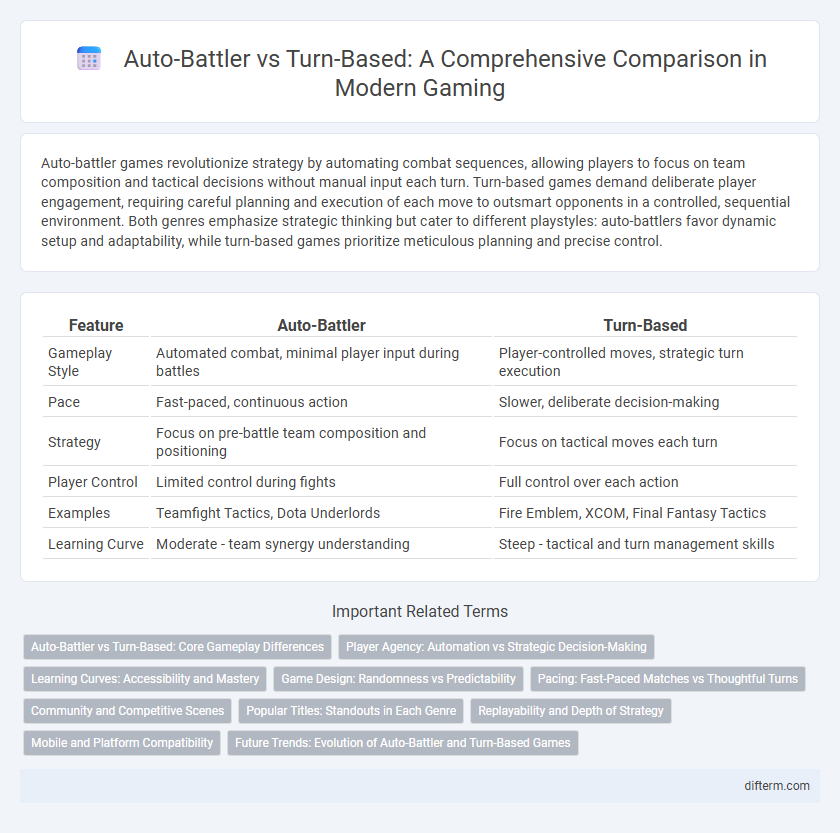Auto-battler games revolutionize strategy by automating combat sequences, allowing players to focus on team composition and tactical decisions without manual input each turn. Turn-based games demand deliberate player engagement, requiring careful planning and execution of each move to outsmart opponents in a controlled, sequential environment. Both genres emphasize strategic thinking but cater to different playstyles: auto-battlers favor dynamic setup and adaptability, while turn-based games prioritize meticulous planning and precise control.
Table of Comparison
| Feature | Auto-Battler | Turn-Based |
|---|---|---|
| Gameplay Style | Automated combat, minimal player input during battles | Player-controlled moves, strategic turn execution |
| Pace | Fast-paced, continuous action | Slower, deliberate decision-making |
| Strategy | Focus on pre-battle team composition and positioning | Focus on tactical moves each turn |
| Player Control | Limited control during fights | Full control over each action |
| Examples | Teamfight Tactics, Dota Underlords | Fire Emblem, XCOM, Final Fantasy Tactics |
| Learning Curve | Moderate - team synergy understanding | Steep - tactical and turn management skills |
Auto-Battler vs Turn-Based: Core Gameplay Differences
Auto-battler games feature automated combat where players focus on strategic unit placement and team composition, while turn-based games require players to actively decide each move during their turn. Auto-battlers emphasize pre-battle strategy and resource management, whereas turn-based games prioritize tactical decision-making and timing in every combat phase. The core gameplay difference lies in player interaction frequency: passive during battles in auto-battlers versus continuous, hands-on control in turn-based games.
Player Agency: Automation vs Strategic Decision-Making
Auto-battlers automate combat sequences, reducing direct player control but emphasizing pre-battle strategy like unit placement and composition. Turn-based games prioritize strategic decision-making during each move, granting players full agency in every combat action. This contrast highlights the trade-off between passive management and active tactical involvement in gameplay dynamics.
Learning Curves: Accessibility and Mastery
Auto-battler games feature streamlined mechanics that lower the initial learning curve, making them highly accessible to newcomers by automating combat sequences and focusing on strategic positioning and team composition. Turn-based games demand a deeper understanding of complex rules, character abilities, and tactical decision-making, which cultivates mastery over a longer period but can deter novice players. The difference in learning curves impacts player engagement, with auto-battlers offering quick entry and turn-based strategies rewarding sustained analytical thinking and skill development.
Game Design: Randomness vs Predictability
Auto-battler games incorporate randomness through automated combat sequences and unpredictable unit interactions, fostering dynamic gameplay that challenges player adaptability. Turn-based games emphasize predictability by allowing players to plan precise strategies with complete control over each move, enhancing tactical depth. This contrast in game design influences player experience by balancing the thrill of uncertainty against the satisfaction of calculated decision-making.
Pacing: Fast-Paced Matches vs Thoughtful Turns
Auto-battlers deliver fast-paced matches where strategic decisions happen before combat, allowing gameplay to flow swiftly without direct player input during battles. Turn-based games emphasize thoughtful turns, requiring players to carefully plan each move, resulting in a slower, more deliberate pacing that prioritizes tactical depth. The choice between auto-battlers and turn-based games hinges on whether players prefer rapid, dynamic gameplay or methodical, strategy-focused experiences.
Community and Competitive Scenes
Auto-battler games like Teamfight Tactics foster large, dynamic communities with frequent updates that keep competitive scenes fresh and accessible, attracting both casual and pro players. Turn-based games such as XCOM maintain a dedicated, strategic player base with deeply tactical gameplay, resulting in niche but passionate competitive tournaments. The auto-battler scene often thrives on social interaction and frequent meta shifts, while turn-based communities emphasize mastery of complex strategies and long-term competitive planning.
Popular Titles: Standouts in Each Genre
Popular auto-battler titles like Teamfight Tactics and Dota Underlords emphasize strategic unit placement and automatic combat resolution, creating fast-paced gameplay centered on adapting compositions in real-time. Turn-based games such as XCOM 2 and Divinity: Original Sin 2 prioritize tactical decision-making and careful planning, allowing players to control each action with precision over a series of turns. Both genres offer distinct playstyles, with auto-battlers appealing to players seeking dynamic, automated battles and turn-based games catering to those who enjoy deliberate and methodical tactical challenges.
Replayability and Depth of Strategy
Auto-battler games offer high replayability through randomized unit compositions and dynamic matchmaking, encouraging players to constantly adapt their strategies in real-time. Turn-based games provide deeper strategic depth by allowing players to carefully plan each move with full information, fostering long-term tactics and complex decision-making. Both genres cater to different player preferences: auto-battlers emphasize adaptability and unpredictability, while turn-based games focus on meticulous planning and strategic foresight.
Mobile and Platform Compatibility
Auto-battler games on mobile platforms offer seamless gameplay with minimal input required, optimizing for shorter play sessions and lower hardware demands, making them ideal for casual gamers. In contrast, turn-based games emphasize strategic depth and player control, often requiring more processing power and larger screen space, which can limit their performance on lower-end mobile devices but excel on tablets and PCs. Cross-platform compatibility increasingly supports both genres, but auto-battlers generally deliver smoother experiences on diverse devices due to simpler mechanics and faster load times.
Future Trends: Evolution of Auto-Battler and Turn-Based Games
Auto-battler games are evolving with advanced AI that enhances strategic decision-making, while turn-based games integrate immersive storytelling and dynamic multiplayer features to attract a broader audience. The rise of cross-platform play and cloud gaming is expected to blur the lines between auto-battler and turn-based mechanics, fostering hybrid gameplay experiences. Emerging technologies like AR and VR will further transform both genres, creating more interactive and visually engaging gaming environments.
auto-battler vs turn-based Infographic

 difterm.com
difterm.com